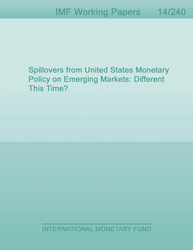
Spillovers from United States Monetary Policy on Emerging Markets: Different This Time?
The impact of monetary policy in large advanced countries on emerging market economies—dubbed spillovers—is hotly debated in global and national policy circles. When the U.S. resorted to unconventional monetary policy, spillovers on asset prices and capital flows were significant, though remained smaller in countries with better fundamentals. This was not because monetary policy shocks changed (in size, sign or impact on stance). In fact, the traditional signaling channel of monetary policy continued to play the leading role in transmitting shocks, relative to other channels, affecting longer-term bond yields. Instead, we find that larger spillovers stem more from structural factors, such as the use of new instruments (asset purchases). We obtain these results by developing a new methodology to extract, separate, and interpret U.S. monetary policy shocks.
Publication date: December 2014
ISBN: 9781498380423
$18.00
Add to Cart by clicking price of the language and format you'd like to purchase
Available Languages and Formats
| English |
Prices in red indicate formats that are not yet available but are forthcoming.
Topics covered in this book
This title contains information about the following subjects.
Click on a subject if you would like to see other titles with the same subjects.
Economics- Macroeconomics , Economics / General , International - Economics , monetary policy announcements , unconventional monetary policies , spillovers , capital flows , equity markets , bond markets , exchange rates , emerging markets
Summary
Copyright © 2010 - 2024
Powered by:
AIDC



